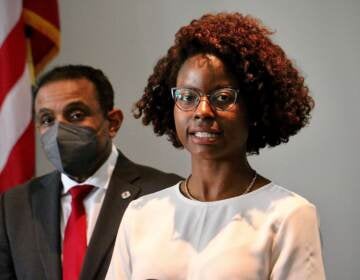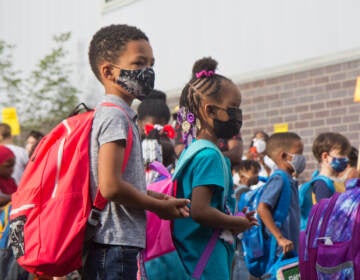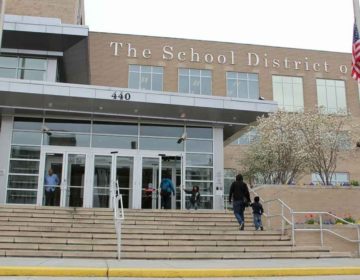Online equity would require more than Chromebooks
Wealthier districts have a "10-year head start" on devices, online access, and virtual curriculum.
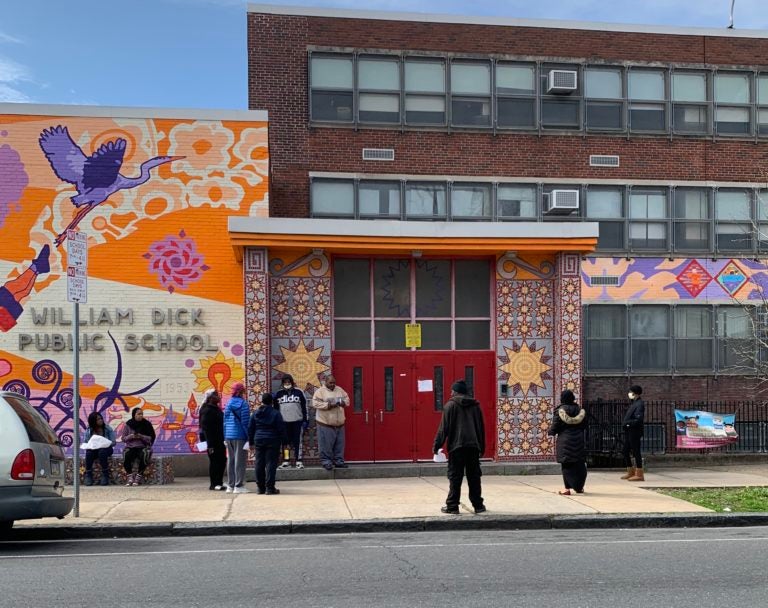
People outside William Dick Elementary School in North Philadelphia waited to pick up Chromebooks on April 7. (The Notebook)
This article originally appeared on The Notebook.
—
Some well-funded school districts in Pennsylvania have barely missed a beat as they’ve transitioned to virtual education after schools were closed due to COVID-19. Students have devices; families have internet access; schools have well-established online classes and resources.
Not so in Philadelphia, where a month into the shutdown, some students still can’t even get online.
Some of those are almost certainly in Mattie Davis’ 1st-grade class at William Dick Elementary School in North Philadelphia. Of her 23 students, a good number of them live in Raymond Rosen Manor, run by the Philadelphia Housing Authority. She knows that many families do not have access to the internet.
“I’m going to be on them about that,” said Davis, and by “them,” she meant the city, the Philadelphia School District, and the region’s internet providers.
Davis grew up in North Philadelphia, still lives there, and has taught in its schools for 29 years. She’ll soon be calling her councilman, who happens to be City Council President Darrell Clarke, with a message: Because traditional schooling is quite possibly finished for the year, all of the city’s students must have the opportunity to learn online.
“We have to find a way,” she said.
Since the onset of the coronavirus crisis, the Philadelphia School District has been trying to rapidly close the technology gap that separates it from its plugged-in suburban peers. The sudden closure of schools left thousands of students with little or no access to computers and triggered widespread calls for an equitable solution.
In response, at its March 23 meeting, the Board of Education approved $11 million to buy up to 50,000 Chromebooks to distribute to students. Schools also loaned out laptops that they had on hand for in-classroom use, and private donors stepped in to help defray the cost.
Teachers were trained last week on Google Classroom and other tools, and next week is for uploading materials and making other preparations.
Superintendent William Hite says online learning will start in earnest in the District on April 20.
Hite acknowledged that online learning will be harder for some students than others. Some may need to take care of siblings while their parents work, Hite said. Others, he acknowledges, may not have internet access, even after getting Chromebooks.
“There could be multiple reasons, and we want to understand all the variables families are dealing with before we start grading,” Hite said. “There are lots of things to figure out.”
The crisis is not only laying bare the educational inequity in Pennsylvania – and elsewhere, for that matter – but is also likely exacerbating it, according to educators and advocates.
Some area districts have been able to keep classes going and students learning. A recent survey by Public Citizens for Children & Youth found that 37 school districts in the five-county Philadelphia area “have already given out laptops or comparable devices to all or most of their students, and instruction is commencing.” But the same survey found that dozens of other districts have just begun the online transition. Some are distributing laptops and organizing classes; others are surveying families to see what is needed.
And the differences can be seen not just between Philadelphia and more affluent districts, but among schools in the city as well.
In a media call with reporters Friday, Hite said that 43 District schools had received laptops for distribution, and many had already given out computers to all their students. But he said the effort would present monumental challenges for many schools, particularly those with large numbers of low-income students and English learners such as Northeast High School, where 3,400 students speak dozens of languages and hail from cultural and demographic backgrounds of all kinds.
Similar inequities are evident in the city’s charter schools, which educate more than 60,000 students, and in private schools, which range from the tony and expensive to those just scraping by.
“Moving 240,000 students to virtual instruction is an immense endeavor, but it is a worthy effort to ensure students are able to continue learning,” said a statement from the Philadelphia School Partnership, which arranged for the donation of $4 million to buy Chromebooks for students in charter and Catholic Independence Mission schools. “The digital divide is an immediate and expansive obstacle.”
District officials did not provide a complete breakdown of schools’ digital capacity or the status of their laptop distribution. But among the District schools with shorter distance-learning timelines is Science Leadership Academy, a special admission school that already had a one-to-one student-to-computer ratio as part of its project-based instructional model. To ensure that the laptops are useful to students, principal Chris Lehmann said, the school has connected all SLA students with Comcast’s offer of two free months of Internet Essentials, the company’s $9.95-a-month basic broadband service.
Carver High School of Engineering & Science, another special admission school, has also distributed its laptops or otherwise made sure students have computers that they can use to access online work.
But in other schools, the process has just begun, and students have little idea what distance learning will look like.
At Bartram High, a neighborhood school in Southwest Philadelphia that ranks as one of the city’s most beleaguered, laptop distribution has just begun. On Monday, a steady trickle of students and parents showed up to pick up their new Chromebooks. They said they were glad to get the computers, but hadn’t been told what they would do with them.
“When you go in, they make you stand six feet apart, and they do one at a time. You sign papers, they give you a Chromebook and then you leave,” said Bartram student Sabrea Newman.
Newman and two friends, all sophomores, said they weren’t told anything about what is on the computer or what programs they would be using for classes or instruction.
“It’s just a regular Chromebook,” Newman said.
Students and parents are also unsure who to call if they have questions or technical problems, or if they have to pay for anything they lose or break.
Also at Bartram was parent Kisha Booker, who picked up two Chromebooks for her sons, ages 15 and 17.
She said the boys are not yet bored and are “actually happy to be home.” They like that they’re not dealing with the distractions of traditional school. Her family has internet access and a couple of laptops in the house already, Booker said, but she needs to use one for work, and her younger daughter needs one for her own, so the two new ones will help the boys focus.
She hopes that the online learning will be effective, she said, but so far hope is all she’s got. Asked whether she’s received any guidance or instructions from the District, Booker laughed ruefully: “Nope.”
Booker said that she planned to keep tabs on the District’s website and wait for phone calls or emails, but that she’d reach out on her own if she had to. Communication with the District is always a challenge, Booker said, and she hopes it improves. Officials “should definitely keep in contact and keep everybody on the same page about what is going on,” she said.
Shifting approach
The fact that many suburban students are already online should be no surprise, said Donna Cooper, executive director of the advocacy group Public Citizens for Children & Youth. It’s been 10 years since Lower Merion School District decided that every student needed a laptop. Since then, as Philadelphia has struggled through funding crises and charter school controversies, some suburban districts have been quietly integrating online learning with the traditional classroom experience.
That leaves the students who are already online with a massive – and unjust – advantage, Cooper said.
“They had a 10-year head start on urban and poor districts that didn’t have any money to buy technology,” said Cooper. “That’s the root of the problem.”
The sudden shutdown laid Philadelphia’s online shortcomings bare. The District tried to pivot quickly, but its effort got off to a rocky start. Within days of the coronavirus shutdown, Hite told teachers not to offer virtual instruction due to concerns about equity – it wouldn’t be fair to teach just those children who could get online, officials concluded. An immediate outcry followed, and since then, the District has gradually “evolved” in its approach, Hite has said.
First, teachers were told they could offer basic online instruction and support, but not grades. Then, District officials began cobbling together a comprehensive distance learning plan.
But even as that plan has started to take shape, the exact digital needs of Philadelphia’s students has remained unclear.
It is widely believed that thousands of students do not have reliable access to the internet, and without it, a Chromebook is useless. But there is no reliable estimate of exactly how many students fit this profile.
The District issued a detailed directive for engagement when schools have completed Chromebook distribution. Last month, it started giving out learning guides at sites where students can pick up meals. The guides, also posted online, cover about six weeks of “review and enrichment.”
Hite said that when online learning formally begins, the first two weeks will continue “review and enrichment.” New material could be taught and graded as early as May 4, Hite said, but that remains a target, not a promise.
“We are working on that plan right now with teachers and students,” Hite said. “This is new to a lot of people. If students are going to be graded, we don’t want them to be punished … due to circumstances that are essentially out of their control.”
As the city’s deputy chief information officer for innovation management, Andrew Buss is in charge of internet connectivity issues. He said that the most recent estimates show that between 20% and 28% of Philadelphia households do not have access to broadband.
He thinks Comcast’s offer of free Internet Essentials for two months “is a good one,” but acknowledges that universal access to online learning for students will be a “challenge” even with the “herculean” effort to make Chromebooks available to all.
A wider solution, such as a citywide broadband network, is not feasible in the short term or perhaps even the long term. Right now, Pennsylvania law precludes a municipality from taking that step, even if they could, Buss said.
“We need to revise this law, and hopefully this pandemic, one of the things that comes from it is to do away with the law and start encouraging broadband deployment, because now it’s obvious that it’s part of the social safety net,” said Devren Washington, policy director of the Media Mobilizing Project, an activist group.
Inequity comes into focus
As the shutdown drags on, the depth and breadth of inequities in the education system are becoming more obvious, and not just regarding internet connectivity.
“Suburban districts have had a greater ability and facility to use online learning, because it is used more in their day-to-day instruction,” said PCCY’s Cooper. “Those teachers are more proficient in the utilization of technology than those in districts that don’t have two dimes to scrape together” for much beyond the basics.
So the current crisis, she said, shows that the wealthier districts had options that poorer districts didn’t – and that the poorer districts’ students are effectively receiving an obsolete education as a result. “This says to me that day-to-day instruction in the poorest districts is antiquated due to resource starvation, and that is harming our students,” said Cooper.
The resource deprivation is at its starkest in the ability to adequately serve students with special needs. Advocates who first raised that issue sent another letter to Gov. Wolf and state Education Secretary Pedro Rivera on Friday asking for “clear, detailed guidance” to school districts “that can ensure equitable access to education and compliance with federal protections for vulnerable student populations” during the COVID-19 school shutdown.
Those populations include students with disabilities, as well as English learners and those living in poverty.
The letter from the Education Law Center, a follow-up to one sent last month and signed by more than 70 organizations that work for equal rights, detailed promising practices in other school districts – including both wealthier suburbs and some urban areas.
The letter cites examples from some districts’ plans, including the North Allegheny district, a well-off suburb of Pittsburgh, where online learning started March 23.
These programs and “innovative strategies” can “provide needed support to students and parents, and deliver individualized programming and a free appropriate public education for students with disabilities,” the letter said.
Concern about whether it was possible to provide a “free, appropriate public education” to all students, as mandated in federal and state law, caused the Philadelphia School District and some others to initially shy away from trying to provide any organized online instruction, or “continuity of education.” Ultimately, federal and state guidelines were modified, and Rivera offered guidance that “strongly encourages” each district in Pennsylvania to make a “good faith effort” within its means to meet the needs of all students.
The advocates have made it clear that their concerns for the rights of all students should not stymie any effort to provide education during this unprecedented situation. At the same time, they remain vigilant about what school districts should at least be attempting to do, regardless of their circumstances.
It notes, for instance, that the current guidelines allow districts not to accept any new students, which can leave some highly transient students, including those in foster care, with no place at all to receive an education.
“As LEAs (local education agencies, including school districts and charters) increasingly move towards online learning platforms for the delivery of continuity of education plans, the Department must issue guidance regarding the need to consider the multifaceted ‘digital divide’ that exists for students living in poverty,” the letter says. “Providing a Chromebook or laptop alone will not solve digital access issues for students living in poverty. LEAs also need to assess and ensure reliable internet connectivity for students.”
Davis, the teacher at William Dick, is doing her best to make sure her 1st graders, who are in the crucial stages of learning to read, are kept engaged. Earlier this month, she went around to all their houses to push the printed packets through mail slots – keeping her distance, of course – to make sure they had work to do.
She has taken the training and is working to master the elements of virtual life that she hasn’t used before, such as Zoom, the online meeting platform. In addition to giving her students work over Google Classroom – she has already posted the Langston Hughes poem “April Rain Song” to read – she wants to use Zoom “so I can see their faces.”
In the Raymond Rosen complex, the community center has internet availability, but that is not a good option due to social distancing requirements. There needs to be a better solution for her students, Davis said.
Families from William Dick Elementary picked up their Chromebooks on Tuesday, April 7, and Davis was appreciative that Comcast CEO Brian Roberts and his family donated $5 million toward their purchase.
“The donation was very nice,” she said. “But besides the $5 million, what about making sure we have accessibility for all the children so when they get the Chromebooks, they are not just a cute, shiny toy, and they can actually use them?”
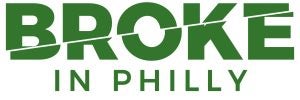 WHYY News is one of more than 20 news organizations producing Broke in Philly, a collaborative reporting project on economic mobility. Read more at brokeinphilly.org or follow at @brokeinphilly.
WHYY News is one of more than 20 news organizations producing Broke in Philly, a collaborative reporting project on economic mobility. Read more at brokeinphilly.org or follow at @brokeinphilly.
WHYY is your source for fact-based, in-depth journalism and information. As a nonprofit organization, we rely on financial support from readers like you. Please give today.


![CoronavirusPandemic_1024x512[1]](https://whyy.org/wp-content/uploads/2020/03/CoronavirusPandemic_1024x5121-300x150.jpg)
